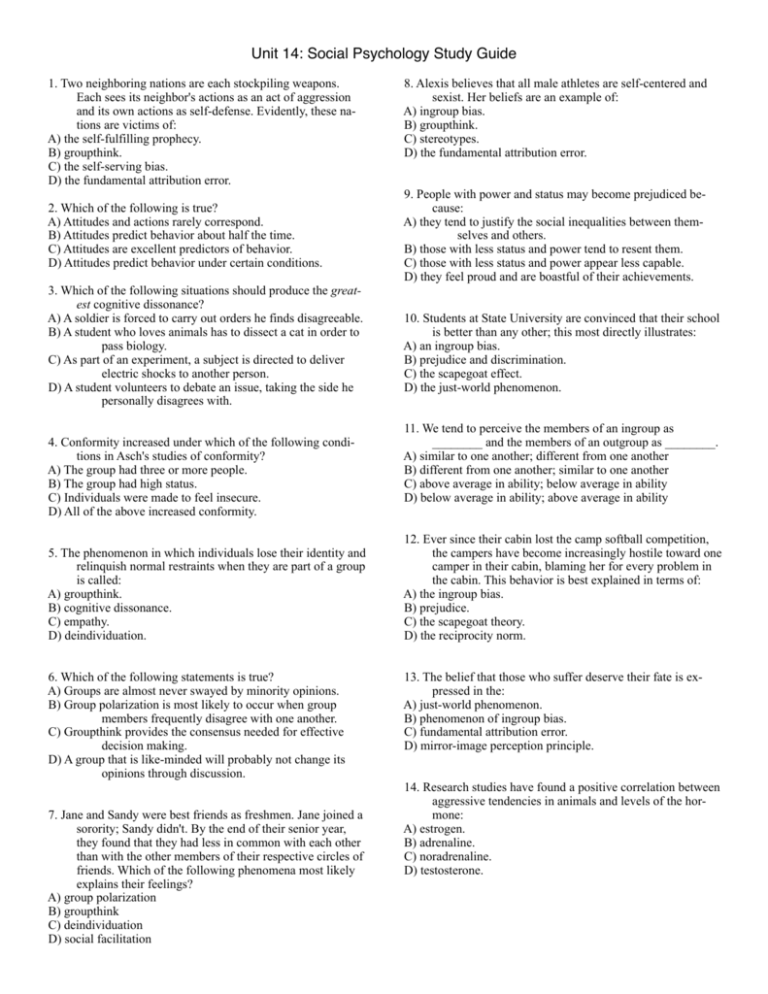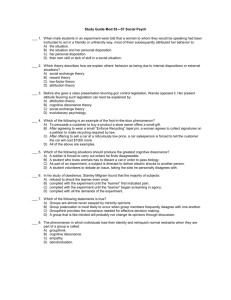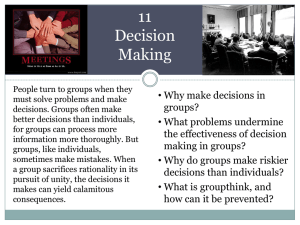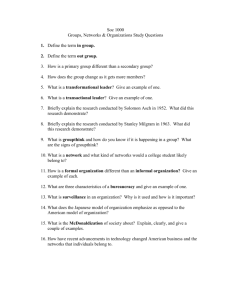Unit 14: Social Psychology Study Guide
advertisement

Unit 14: Social Psychology Study Guide 1. Two neighboring nations are each stockpiling weapons. Each sees its neighbor's actions as an act of aggression and its own actions as self-defense. Evidently, these nations are victims of: A) the self-fulfilling prophecy. B) groupthink. C) the self-serving bias. D) the fundamental attribution error. 2. Which of the following is true? A) Attitudes and actions rarely correspond. B) Attitudes predict behavior about half the time. C) Attitudes are excellent predictors of behavior. D) Attitudes predict behavior under certain conditions. 3. Which of the following situations should produce the greatest cognitive dissonance? A) A soldier is forced to carry out orders he finds disagreeable. B) A student who loves animals has to dissect a cat in order to pass biology. C) As part of an experiment, a subject is directed to deliver electric shocks to another person. D) A student volunteers to debate an issue, taking the side he personally disagrees with. 4. Conformity increased under which of the following conditions in Asch's studies of conformity? A) The group had three or more people. B) The group had high status. C) Individuals were made to feel insecure. D) All of the above increased conformity. 5. The phenomenon in which individuals lose their identity and relinquish normal restraints when they are part of a group is called: A) groupthink. B) cognitive dissonance. C) empathy. D) deindividuation. 6. Which of the following statements is true? A) Groups are almost never swayed by minority opinions. B) Group polarization is most likely to occur when group members frequently disagree with one another. C) Groupthink provides the consensus needed for effective decision making. D) A group that is like-minded will probably not change its opinions through discussion. 7. Jane and Sandy were best friends as freshmen. Jane joined a sorority; Sandy didn't. By the end of their senior year, they found that they had less in common with each other than with the other members of their respective circles of friends. Which of the following phenomena most likely explains their feelings? A) group polarization B) groupthink C) deindividuation D) social facilitation 8. Alexis believes that all male athletes are self-centered and sexist. Her beliefs are an example of: A) ingroup bias. B) groupthink. C) stereotypes. D) the fundamental attribution error. 9. People with power and status may become prejudiced because: A) they tend to justify the social inequalities between themselves and others. B) those with less status and power tend to resent them. C) those with less status and power appear less capable. D) they feel proud and are boastful of their achievements. 10. Students at State University are convinced that their school is better than any other; this most directly illustrates: A) an ingroup bias. B) prejudice and discrimination. C) the scapegoat effect. D) the just-world phenomenon. 11. We tend to perceive the members of an ingroup as ________ and the members of an outgroup as ________. A) similar to one another; different from one another B) different from one another; similar to one another C) above average in ability; below average in ability D) below average in ability; above average in ability 12. Ever since their cabin lost the camp softball competition, the campers have become increasingly hostile toward one camper in their cabin, blaming her for every problem in the cabin. This behavior is best explained in terms of: A) the ingroup bias. B) prejudice. C) the scapegoat theory. D) the reciprocity norm. 13. The belief that those who suffer deserve their fate is expressed in the: A) just-world phenomenon. B) phenomenon of ingroup bias. C) fundamental attribution error. D) mirror-image perception principle. 14. Research studies have found a positive correlation between aggressive tendencies in animals and levels of the hormone: A) estrogen. B) adrenaline. C) noradrenaline. D) testosterone. Unit 14: Social Psychology Study Guide 15. Regarding the influence of alcohol and testosterone on aggressive behavior, which of the following is true? A) Consumption of alcohol increases aggressive behavior; injections of testosterone reduce aggressive behavior. B) Consumption of alcohol reduces aggressive behavior; injections of testosterone increase aggressive behavior. C) Consumption of alcohol and injections of testosterone both promote aggressive behavior. D) Consumption of alcohol and injections of testosterone both reduce aggressive behavior. 16. Research studies have shown that frequent exposure to sexually explicit films: A) makes a woman's friendliness seem more sexual. B) diminishes the attitude that rape is a serious crime. C) may lead individuals to devalue their partners. D) may produce all of the above effects. 17. Research studies have indicated that the tendency of viewers to misperceive normal sexuality, devalue their partners, and trivialize rape is: A) increased by exposure to pornography. B) not changed after exposure to pornography. C) decreased in men by exposure to pornography. D) decreased in both men and women by exposure to pornography. 18. Most researchers agree that: A) media violence is a factor in aggressive behavior. B) there is a negative correlation between media violence and aggressiveness. C) paradoxically, watching excessive pornography ultimately diminishes an individual's aggressive tendencies. D) media violence is too unreal to promote aggression in viewers. 19. Most people prefer mirror-image photographs of their faces. This is best explained by: A) the principle of equity. B) the principle of self-disclosure. C) the mere exposure effect. D) mirror-image perceptions. 20. Ahmed and Monique are on a blind date. Which of the following will probably be most influential in determining whether they like each other? A) their personalities B) their beliefs C) their social skills D) their physical attractiveness 21. Having read the chapter, which of the following is best borne out by research on attraction? A) Birds of a feather flock together. B) Opposites attract. C) Familiarity breeds contempt. D) Absence makes the heart grow fonder. 22. Opening her mail, Joan discovers a romantic greeting card from her boyfriend. According to the two-factor theory, she is likely to feel the most intense romantic feelings if, prior to reading the card, she has just: A) completed her daily run. B) finished reading a chapter in her psychology textbook. C) awakened from a nap. D) finished eating lunch. 23. The deep affection that is felt in long-lasting relationships is called ________ love; this feeling is fostered in relationships in which ________. A) passionate; there is equity between the partners B) passionate; traditional roles are maintained C) companionate; there is equity between the partners D) companionate; traditional roles are maintained 24. According to social exchange theory, a person's tendency toward altruistic behavior is based on: A) a determination of the relatedness of those who will be affected. B) a cost-benefit analysis of any action. C) social norms. D) all of the above. 25. After Sandy helped Jack move into his new apartment, Jack felt obligated to help Sandy when she moved. Jack's sense of responsibility can best be explained by: A) evolutionary psychology. B) two-factor theory. C) the social responsibility norm. D) the reciprocity norm. Answer Key - Unit14SG.2012-2013 1. 2. 3. 4. 5. 6. 7. 8. 9. 10. 11. 12. 13. 14. 15. 16. 17. 18. 19. 20. 21. 22. 23. 24. 25. D D D D D D A C A A B C A D C D A A C D A A C B D








